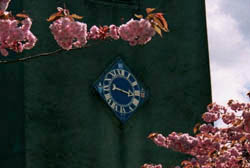




|

|
Part: | 1 | 2 | 3 | 4 | 
|

|
 On the north side of the tower is the face of the old church clock, with only one hand, which was set going, after a stoppage of sixty years, in 1898; but after a while it stopped again, and, finally, the machinery was found to be too worn out to be any longer in working order. The only old cross on the church, and presumably of 14th century date, is that on the gable of the north transept.
On the north side of the tower is the face of the old church clock, with only one hand, which was set going, after a stoppage of sixty years, in 1898; but after a while it stopped again, and, finally, the machinery was found to be too worn out to be any longer in working order. The only old cross on the church, and presumably of 14th century date, is that on the gable of the north transept.
|

|
Part: | 1 | 2 | 3 | 4 | 
|

|